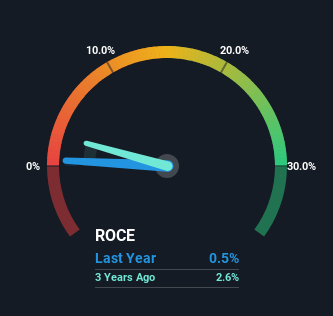Capital Allocation Trends At China Kangda Food (SGX:P74) Aren't Ideal

If you're looking at a mature business that's past the growth phase, what are some of the underlying trends that pop up? A business that's potentially in decline often shows two trends, a return on capital employed (ROCE) that's declining, and a base of capital employed that's also declining. Trends like this ultimately mean the business is reducing its investments and also earning less on what it has invested. So after glancing at the trends within China Kangda Food (SGX:P74), we weren't too hopeful.
What Is Return On Capital Employed (ROCE)?
For those that aren't sure what ROCE is, it measures the amount of pre-tax profits a company can generate from the capital employed in its business. To calculate this metric for China Kangda Food, this is the formula:
Return on Capital Employed = Earnings Before Interest and Tax (EBIT) ÷ (Total Assets - Current Liabilities)
0.005 = CN¥3.1m ÷ (CN¥1.5b - CN¥889m) (Based on the trailing twelve months to June 2023).
Therefore, China Kangda Food has an ROCE of 0.5%. In absolute terms, that's a low return and it also under-performs the Food industry average of 8.6%.
Check out our latest analysis for China Kangda Food

Historical performance is a great place to start when researching a stock so above you can see the gauge for China Kangda Food's ROCE against it's prior returns. If you're interested in investigating China Kangda Food's past further, check out this free graph of past earnings, revenue and cash flow.
What Does the ROCE Trend For China Kangda Food Tell Us?
In terms of China Kangda Food's historical ROCE movements, the trend doesn't inspire confidence. To be more specific, the ROCE was 1.9% five years ago, but since then it has dropped noticeably. And on the capital employed front, the business is utilizing roughly the same amount of capital as it was back then. Since returns are falling and the business has the same amount of assets employed, this can suggest it's a mature business that hasn't had much growth in the last five years. So because these trends aren't typically conducive to creating a multi-bagger, we wouldn't hold our breath on China Kangda Food becoming one if things continue as they have.
On a separate but related note, it's important to know that China Kangda Food has a current liabilities to total assets ratio of 59%, which we'd consider pretty high. This effectively means that suppliers (or short-term creditors) are funding a large portion of the business, so just be aware that this can introduce some elements of risk. While it's not necessarily a bad thing, it can be beneficial if this ratio is lower.
In Conclusion...
In the end, the trend of lower returns on the same amount of capital isn't typically an indication that we're looking at a growth stock. This could explain why the stock has sunk a total of 77% in the last five years. That being the case, unless the underlying trends revert to a more positive trajectory, we'd consider looking elsewhere.
One more thing: We've identified 3 warning signs with China Kangda Food (at least 2 which are potentially serious) , and understanding them would certainly be useful.
While China Kangda Food isn't earning the highest return, check out this free list of companies that are earning high returns on equity with solid balance sheets.
New: AI Stock Screener & Alerts
Our new AI Stock Screener scans the market every day to uncover opportunities.
• Dividend Powerhouses (3%+ Yield)
• Undervalued Small Caps with Insider Buying
• High growth Tech and AI Companies
Or build your own from over 50 metrics.
Have feedback on this article? Concerned about the content? Get in touch with us directly. Alternatively, email editorial-team (at) simplywallst.com.
This article by Simply Wall St is general in nature. We provide commentary based on historical data and analyst forecasts only using an unbiased methodology and our articles are not intended to be financial advice. It does not constitute a recommendation to buy or sell any stock, and does not take account of your objectives, or your financial situation. We aim to bring you long-term focused analysis driven by fundamental data. Note that our analysis may not factor in the latest price-sensitive company announcements or qualitative material. Simply Wall St has no position in any stocks mentioned.
About SGX:P74
China Kangda Food
An investment holding company, produces, processes, sells, and distributes food products in the People’s Republic of China.
Good value with adequate balance sheet.
Market Insights
Community Narratives



